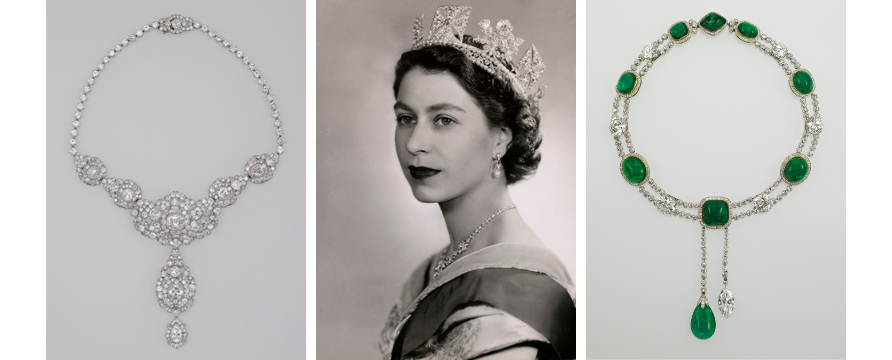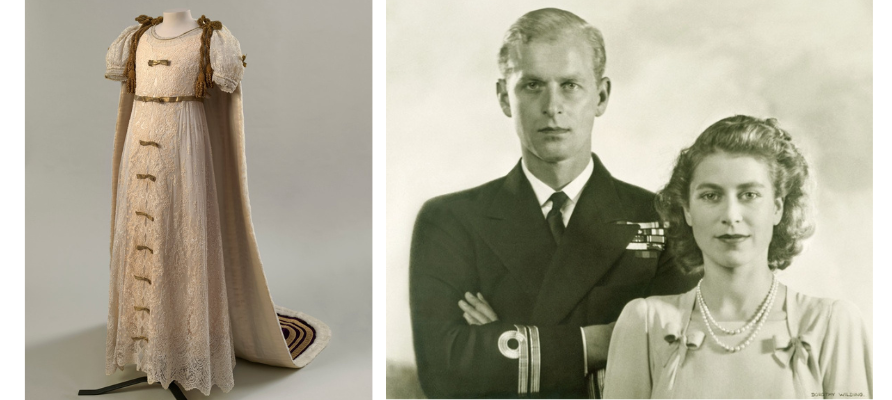
Royal Collection Trust / © Her Majesty Queen Elizabeth II 2022
Jewels from the Queen’s personal collection and iconic photographs are on display at Buckingham Palace, as part of a visit to the Summer Opening of the State Rooms, which have opened for the first time since 2019.
The special display Platinum Jubilee: The Queen’s Accession celebrates the start of the Queens historic reign and centres around 24 official portraits of Her Majesty, taken by the photographer Dorothy Wilding. For the first time, Wilding’s original hand-finished prints are shown alongside items of jewellery worn by the Queen for the portrait settings, some of which have never been on public display before.
Dorothy Wilding began taking photographs of members of the Royal Family in the 1920s. In May 1937 she became the first official female royal photographer when she was appointed to take the portraits at the coronation of King George VI and Queen Elizabeth. The 11-year-old Princess Elizabeth featured in the photographs along with her sister Princess Margaret, and the display at Buckingham Palace will include the embellished cream dress, purple robe and gold coronet worn by the young Princess for her parents’ coronation.
Ten years later in July 1947, Wilding was called upon to capture the official engagement portraits for Princess Elizabeth and Lieutenant Philip Mountbatten, and in February 1952, she was commissioned to take the first official photographs of the new Queen Elizabeth, just 20 days after the Accession. The series of photographs that Wilding took during this session and a second session two months later have become some of the most enduring images of the Royal Family, and of 20th-century Britain more generally, as they form the basis for the profiles and silhouettes for the Queen that we see on stamps and coins to this day.

Royal Collection Trust / © Her Majesty Queen Elizabeth II 2022
Visitors can enjoy many items of jewellery worn by the Queen, which hold personal connections. These include the South Africa necklace, given to Princess Elizabeth for her 21st birthday by the Government and Union of South Africa. The necklace originally consisted of 21 brilliant-cut diamonds, but in 1952 it was shortened and the six removed stones were made into a matching bracelet, which are also on display.
One of the Queen’s most recognisable jewels is The Girls of Great Britain and Ireland Tiara. The diamond tiara was a gift to the future Queen Mary, on the occasion of her marriage to the future King George V in 1893. Queen Mary in turn gave the tiara as a wedding present to her granddaughter, Princess Elizabeth, in November 1947, along with the Dorset Bow Brooch and a pair of diamond bangles. The bangles, on display for the first time, are thought to have been made in India, where traditionally one would be worn on each wrist to signify matrimony.
Another wedding gift was the Nizam of Hyderabad necklace. The Nizam (ruler) of Hyderabad left instructions with the firm of Cartier in London that Princess Elizabeth should select a wedding gift herself, and this platinum necklace set with approximately 300 diamonds was chosen. The Queen wore the necklace for her second sitting with Dorothy Wilding in April 1952, and it was these photographs that were chosen to form the basis of the Queen’s image on postage stamps from 1953 until 1971.
For her final sitting with Wilding, the Queen wore the Delhi Durbar necklace, which incorporates nine emeralds and was originally owned by the Queen Mary’s grandmother, the Duchess of Cambridge, as well as an 8.8 carat diamond pendant cut from the Cullinan diamond – the largest diamond ever found. It was made for Queen Mary as part of a suite of jewellery created for the Delhi Durbar in 1911, and was inherited by the Queen in 1953. The accompanying emerald and diamond earrings are also on display for the first time.
To learn more about this display, click here.








